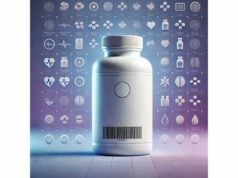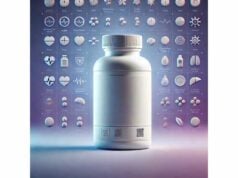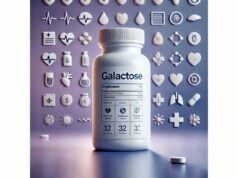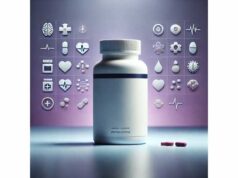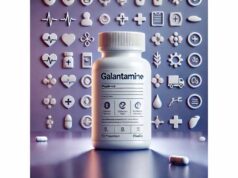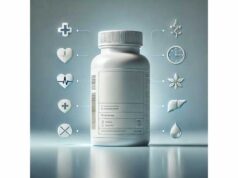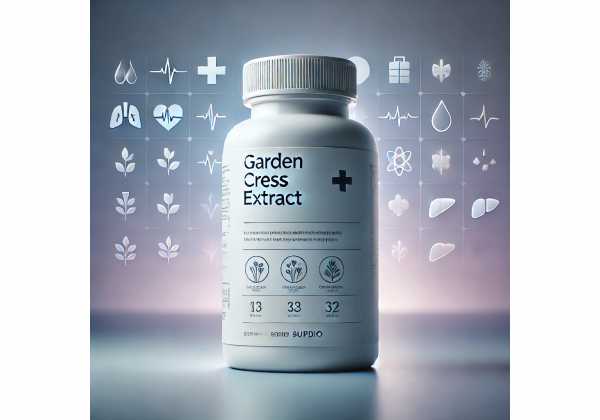
Garden cress extract comes from the fast-growing herb Lepidium sativum, a peppery member of the Brassicaceae family enjoyed as sprouts, seeds, and seed oil. As a supplement, it’s valued for bioactive compounds such as glucosinolates (notably benzyl glucosinolate), their isothiocyanate breakdown products, phenolic acids, flavonoids, and a soothing seed mucilage. Early research suggests roles in metabolic health, inflammation control, bone support, and digestive comfort. Traditional use highlights its iron-rich seeds, culinary versatility, and thickening mucilage that can calm the gut. Yet not all benefits are equally proven in humans, and concentrated extracts deserve the same respect you’d give any potent plant medicine. This guide walks you through what it is, where the evidence stands, how to use it well, what to buy, and how to stay safe—so you can make an informed, practical decision that fits your goals and health context.
Quick Overview
- May support inflammatory balance and metabolic health; strongest evidence for bone support is preclinical.
- Start with 1–3 g/day seed powder or 250–500 mg/day extract, then adjust cautiously.
- Concentrated brassica extracts may not suit people with thyroid disorders or iodine deficiency.
- Avoid use if pregnant, trying to conceive, or taking immunosuppressants without clinician guidance.
Table of Contents
- What is garden cress extract?
- Does garden cress extract work?
- Evidence-based benefits and uses
- How to take it and dose
- What to look for in products
- Side effects, interactions, who should avoid
What is garden cress extract?
Garden cress (Lepidium sativum) is a pungent, fast-growing herb enjoyed worldwide as microgreens and sprouts. Traditional cuisines also use its small reddish-brown seeds and seed oil. When you see “garden cress extract” on a supplement label, it typically refers to a concentrated preparation made from the seeds (most common), the aerial parts, or less often the sprouts. Extracts are usually standardized to certain phytochemicals or prepared by solvent extraction (water, ethanol, or hydroalcoholic methods) and then dried into a powder for capsules or tablets.
Why do people take it? The seeds are rich in:
- Glucosinolates, especially benzyl glucosinolate (glucotropaeolin), which can convert to benzyl isothiocyanate (BITC)—a compound studied for antimicrobial, antioxidant, and cell-protective signaling effects.
- Polyphenols and flavonoids (e.g., sinapic acid derivatives), which contribute to antioxidant capacity and may influence inflammatory pathways.
- Mucilage, a gel-forming polysaccharide in the seed coat that can soothe the gastrointestinal tract and improve stool consistency.
- Minerals and proteins, with notable iron content in the whole seeds (relevant nutritionally but not a reason to megadose supplements).
It helps to distinguish three practical “forms” you’ll encounter:
- Seed powder (culinary or encapsulated): ground whole seeds with naturally occurring fiber, oil, and mucilage.
- Standardized extract (capsules): a concentrated fraction, sometimes listing a ratio (e.g., 10:1) or an active marker (e.g., total glucosinolates or isothiocyanates).
- Seed oil: cold-pressed or solvent-extracted oil rich in fatty acids; used topically or orally for niche purposes, but it lacks the hydrophilic mucilage and many polyphenols.
Mechanistically, garden cress extract is best thought of as a multi-target botanical. Its isothiocyanates can activate cytoprotective Nrf2 pathways and modulate phase II detoxification enzymes; polyphenols help neutralize reactive oxygen species and influence inflammatory mediators (e.g., NF-κB, COX-2); and the mucilage physically supports gut comfort and regularity. None of these actions make it a medicine for a specific disease, but together they can contribute to better resilience under metabolic and inflammatory stress.
Finally, remember that “extract” ≠ “food.” Capsules remove context (like overall diet and iodine status) that matters with Brassica plants. Use modest doses and respect your individual response.
Does garden cress extract work?
Short answer: it may help with certain health goals, but human evidence is limited and varies by outcome. Most strong signals come from laboratory studies and animal models; a smaller number of human studies exist, and they mainly use seed powder rather than purified extracts.
Here’s how the evidence tiers out:
More encouraging (but still developing):
- Bone health support: Preclinical models show improvements in bone strength, mineralization, antioxidant defenses, and favorable changes in the RANKL/OPG axis with seed extracts. In humans, a randomized controlled trial using 1 g seed powder three times daily for six weeks in postmenopausal women receiving nonsurgical periodontal therapy reported better periodontal metrics, with the combined use of seed powder and standard osteoporosis medication showing the greatest effect. While that trial targeted periodontal outcomes, the bone-health context and radiometric indices add plausibility for skeletal benefits.
Promising but preliminary:
- Inflammatory balance and immune modulation: Mechanistic and animal studies consistently show reductions in pro-inflammatory cytokines (e.g., TNF-α, IL-6, IL-1β) and markers of oxidative stress, with contributions from glucosinolates/isothiocyanates and polyphenols. Translating these effects to specific human conditions awaits better trials.
- Metabolic markers (glucose, lipids): Animal and pilot studies suggest improvements in insulin sensitivity and lipid profiles with seed extracts, but robust human data are sparse.
- Gastrointestinal comfort: The seed mucilage has soothing, gel-forming properties that can improve stool form and reduce irritation in traditional use; controlled human data are limited, but the mechanism is straightforward and similar to other soluble fibers.
Less certain or mainly in vitro:
- Antimicrobial and oral health adjuncts: Lab studies show antimicrobial activity; in clinical settings, this is more about adjunctive use with standard care than standalone treatment.
- Skin and wound applications: Topical or specialized preparations appear in preclinical literature; routine skincare claims are not yet supported by clinical trials.
What does this mean for you? If your interest is general inflammatory balance, digestive comfort, or bone-supportive nutrition alongside medical care, garden cress extract (or seed powder) can be a reasonable, modest addition. If you’re seeking treatment for a specific disease, the evidence does not support using it as a replacement for medical therapy. A prudent approach is to try a low dose, monitor concrete outcomes (e.g., stool form, joint comfort, oral health metrics if you’re under dental care), and reassess after 6–8 weeks.
Evidence-based benefits and uses
Below is a practical map of where garden cress extract (or seed powder) fits best—and how strong the evidence is. Each point emphasizes what to expect, how to track progress, and how to combine with lifestyle foundations.
1) Bone and oral-periodontal support (adjunctive)
- What to expect: In animal models, seed extracts improved bone strength and markers of bone formation while reducing oxidative stress in bone tissue. In a human randomized trial, seed powder 1 g three times daily adjunctive to periodontal care improved periodontal scores and radiometric indices in postmenopausal osteoporotic women; combined use with standard osteoporosis medication performed best.
- How to track: If under medical or dental supervision, monitor periodontal measurements (pocket depth, attachment level), dental X-ray indices as advised, and clinician notes on gum health. For skeletal health more broadly, continue standard medical monitoring (BMD scans when due).
- Lifestyle pairing: Adequate calcium, vitamin D, vitamin K intake; resistance and impact exercise; protein adequacy; and fall-prevention strategies.
2) Inflammatory balance and recovery from everyday stressors (supportive)
- What to expect: Isothiocyanates and polyphenols may support antioxidant defenses and modulate pro-inflammatory mediators. People often report subtle changes—less morning stiffness, easier post-exercise recovery, or better gum comfort when combined with flossing and professional care.
- How to track: Subjective symptom logs (joint stiffness score 0–10 upon waking), post-activity soreness, dental hygiene notes. Consider a 6- to 8-week trial before judging effect.
- Lifestyle pairing: Prioritize fiber-rich plants, omega-3 sources, sleep regularity, and stress management; these set the baseline that botanicals can complement.
3) Digestive comfort and stool regularity (gentle, food-like action)
- What to expect: The seed mucilage absorbs water and forms a soft gel that can ease stool transit and soothe irritated mucosa—similar to psyllium or flax, though with a peppery profile.
- How to track: Stool form using the Bristol Stool Chart; aim for type 3–4. Increase fluids as you increase intake to avoid bloating.
- Lifestyle pairing: Hydration and steady dietary fiber. If you’re already using psyllium or acacia fiber, start garden cress at the low end and avoid stacking multiple gel-forming fibers too quickly.
4) Metabolic markers (early-stage evidence)
- What to expect: Preclinical research hints at improved insulin signaling and lipid parameters with seed extracts. Translation to humans remains preliminary, so treat this as a “maybe”, not a guarantee.
- How to track: If you and your clinician agree, follow standard markers (fasting glucose, A1C, fasting lipids) on your normal schedule; do not change prescribed medications without medical direction.
- Lifestyle pairing: Meal rhythm, protein at each meal, movement after eating, and adequate sleep are higher-leverage levers.
5) Topical or culinary uses (complementary, not core)
- Topical: Specialty formulations may appear for wound settings in research; routine consumer skincare benefits are unproven.
- Culinary: Sprouts and lightly ground seeds add peppery zip and nutrition to salads, soups, and flatbreads. Food use is generally gentler than concentrated extracts.
Who is most likely to benefit?
- Adults seeking an adjunct for gum/periodontal care under a dentist’s supervision.
- Individuals who tolerate Brassica foods and want a gentle anti-inflammatory nudge alongside diet and exercise.
- People needing fiber diversity and smoother stool consistency who prefer plant-based options.
Who might not notice much?
- Anyone expecting dramatic, drug-like effects from a single herb.
- People with already excellent diets and well-controlled inflammation may experience only subtle changes.
Bottom line: Garden cress extract is a supportive botanical. It works best when added to a solid foundation of nutrition, sleep, movement, and medical care—not as a standalone fix.
How to take it and dose
Start low, go slow is the smartest approach with Brassica concentrates. Dosing depends on form:
1) Seed powder (whole-food form)
- Typical starting range: 1–3 g/day, divided with meals.
- Studied regimen: 1 g three times daily (total 3 g/day) for six weeks was used as an adjunct in a periodontal trial.
- How to use: Stir into yogurt, smoothies, or warm water; or use capsules providing the same gram amounts. Increase fluids to accommodate added fiber/mucilage.
2) Standardized extract (capsules)
- Typical starting range: 250–500 mg/day of a 10:1 or similar extract, with food.
- Titration: After 1–2 weeks without side effects, some users increase to 500–1,000 mg/day, ideally split with meals.
- Standardization note: Few products state exact glucosinolate or isothiocyanate content. If a label lists total glucosinolates (e.g., benzyl glucosinolate) or isothiocyanates (e.g., BITC), prioritize those with clear, batch-specific testing.
3) Seed oil
- Oral: Not a substitute for extract or powder; doses vary widely (often 1–2 tsp/day culinarily).
- Topical: Follow product directions; evidence for routine skincare is limited.
Timing tips
- Take with meals to improve tolerance and align with bile release for lipophilic components.
- If using for stool regularity, morning and evening with water works well.
- For oral/periodontal support, coordinate with daily hygiene; your dentist may suggest a target duration.
Stacking and combinations
- With bone-supportive nutrients: Pair with calcium, vitamin D, vitamin K2, magnesium, and protein if your diet is low in these.
- With iron-rich meals: If using seed powder as a food, pair with vitamin C–rich foods to support iron absorption (applies to whole seeds, not necessary for extracts).
- Avoid stacking multiple Brassica concentrates (e.g., high-dose broccoli or mustard extracts) at first; evaluate one product at a time.
How long to use
- Trial for 6–8 weeks, reassess, and consider cycling (e.g., 5 days on/2 off, or 8–12 weeks on/2–4 off) if using higher extract doses.
- Long-term food-level use of seed powder is generally reasonable if well tolerated.
Ceiling and cautions
- Without clear human data for high-dose extracts, avoid exceeding 1,000 mg/day of concentrated extract unless supervised.
- For seed powder, staying within 1–6 g/day is a conservative, food-aligned range; more is not necessarily better due to fiber load and glucosinolate exposure.
Troubleshooting
- Bloating or gas: Reduce dose, split more finely, and increase water.
- Peppery taste: Mix with yogurt, applesauce, or a smoothie; capsules avoid flavor altogether.
- No effect after 8 weeks: Reassess goals; this may not be the right tool—or foundations (sleep, diet, exercise) may need attention first.
What to look for in products
The quality gap between brands can be wide. Use this checklist to buy confidently:
1) Plant identity and part
- Look for Lepidium sativum named on the label (not just “garden cress”).
- Prefer products that specify seed as the source for extracts or powder, since most research and traditional use center on seeds.
2) Extraction details
- Good labels state solvent (water, ethanol, hydroalcoholic) and extract ratio (e.g., 10:1).
- If standardized, you should see marker compounds (e.g., “≥ X% total glucosinolates” or a specified benzyl glucosinolate/BITC amount). Lack of any standardization isn’t a dealbreaker for food-like powders but matters for extracts.
3) Independent testing
- Choose brands with third-party testing (identity, potency, heavy metals, microbial counts, pesticides, residual solvents). Look for batch certificates or clear statements.
- Because seeds can concentrate minerals from soil, heavy-metal screening is particularly relevant.
4) Freshness and packaging
- Glucosinolates and isothiocyanates are sensitive to processing. Prefer opaque, well-sealed bottles with desiccants and clear manufacture/expiration dates.
- Avoid products that smell rancid (seed oil should be fresh, nutty, not paint-like).
5) Additives and allergens
- Many capsules are clean, but watch for unnecessary fillers. If you have mustard/Brassicaceae allergies, avoid products that lack allergen statements or batch testing for contaminants.
6) Ethical and regulatory posture
- Reputable companies do not claim to diagnose, treat, or cure diseases. Be wary of dramatic promises about weight loss, disease reversal, or “detox.”
7) Fit to your goal
- Oral/periodontal adjunct: Consider seed powder in the 1–3 g/day range to mirror available human data; involve your dentist if you intend to use it adjunctively.
- Inflammatory balance: A standardized extract (250–500 mg/day to start) may be more convenient; seek products with declared glucosinolate content.
- Digestive comfort: Seed powder or a blend that preserves mucilage is more logical than a purified extract.
Storage tips
- Keep powders and capsules cool, dry, and in the dark.
- Refrigerate seed oil after opening and use within the window on the label.
Side effects, interactions, who should avoid
Most people tolerate culinary amounts of garden cress well. Concentrated extracts and higher seed intakes call for more care.
Common, usually mild
- Digestive effects: Gas, bloating, or softer stools due to mucilage/fiber—especially if you ramp up quickly or don’t increase fluids.
- Taste/sensation: Peppery warmth; harmless but noticeable.
Less common
- Reflux or stomach upset: Reduce dose or take with meals.
- Allergic responses: Rare, but possible in those sensitive to mustard/Brassicaceae; discontinue immediately if you notice hives, swelling, or breathing difficulty.
The thyroid question
Brassica plants contain glucosinolates. In very high, long-term intakes—particularly with poor iodine status—some Brassica foods may affect thyroid hormone synthesis. With garden cress, this risk appears low at typical food levels, but concentrated extracts deserve caution:
- If you have thyroid disease or iodine deficiency, consult your clinician before using concentrated garden cress extracts or stacking multiple Brassica supplements.
- Keep iodine intake adequate (per your clinician), and avoid high doses if labs are unstable.
Blood sugar and blood pressure
Preclinical work suggests potential glucose-lowering effects; in practice, this means:
- If you use antidiabetic medications or insulin, monitor for additive effects and discuss any changes with your clinician.
- For antihypertensives, effects are less defined; basic monitoring is sensible if you add new supplements.
Drug interactions
- A pharmacokinetic study in animals indicated garden cress seeds could modify cyclosporine exposure (changes in absorption and elimination kinetics). While animal data do not equal human outcomes, take this seriously with narrow-therapeutic-index drugs (e.g., cyclosporine).
- As with other botanicals rich in polyphenols and isothiocyanates, theoretical interactions with CYP3A4 and P-gp substrates are possible. If you take transplant, chemotherapy, potent anticoagulant, or antiarrhythmic medications, avoid garden cress extract unless your specialist approves.
Populations who should avoid or get medical guidance first
- Pregnancy or trying to conceive: Safety data for concentrated extracts are lacking; avoid unless your obstetric clinician agrees.
- Breastfeeding: Traditional use of seeds as a galactagogue exists, but robust safety data for extracts are missing—avoid concentrated products.
- Children: Use food forms only and avoid extracts unless a pediatric clinician advises.
- Kidney stone history (oxalate-sensitive): Seeds contain antinutrients such as oxalates; stay conservative and hydrate well, or choose another fiber source.
When to stop and seek help
- Persistent GI distress, allergic signs, thyroid symptom changes (new palpitations, heat/cold intolerance), or unexplained changes in medication effects are reasons to stop and contact your clinician.
Practical safety habits
- Introduce one new supplement at a time.
- Keep a simple log of dose, timing, and any changes you notice.
- Re-evaluate the need after 8 weeks; if there’s no clear benefit, discontinue.
References
- Garden cress seeds: a review on nutritional composition, therapeutic potential, and industrial utilization 2024 (Systematic Review)
- Anti-inflammatory and Immunomodulatory Properties of Lepidium sativum 2022 (Systematic Review)
- Osteoprotective Activity and Metabolite Fingerprint via UPLC/MS and GC/MS of Lepidium sativum in Ovariectomized Rats 2020
- Clinical and Radiographic Assessment of Single or Combined Treatment with Lepidium sativum and Alendronate of Non-Surgically Treated Chronic Periodontitis in Postmenopausal Osteoporotic Women 2019 (RCT)
- Effects of Nigella sativa and Lepidium sativum on Cyclosporine Pharmacokinetics 2013
Disclaimer
This article is for educational purposes only and is not a substitute for professional medical advice, diagnosis, or treatment. Do not start, stop, or change any medication or supplement regimen without guidance from a qualified healthcare professional who understands your medical history, medications, and goals. If you are pregnant, breastfeeding, have thyroid disease, take transplant or chemotherapy medicines, or manage chronic conditions, seek personalized advice before using garden cress extract.
If you found this helpful, please consider sharing it on Facebook, X (formerly Twitter), or your favorite platform, and follow us for more evidence-based guides. Your support helps us keep producing quality content. Thank you.

